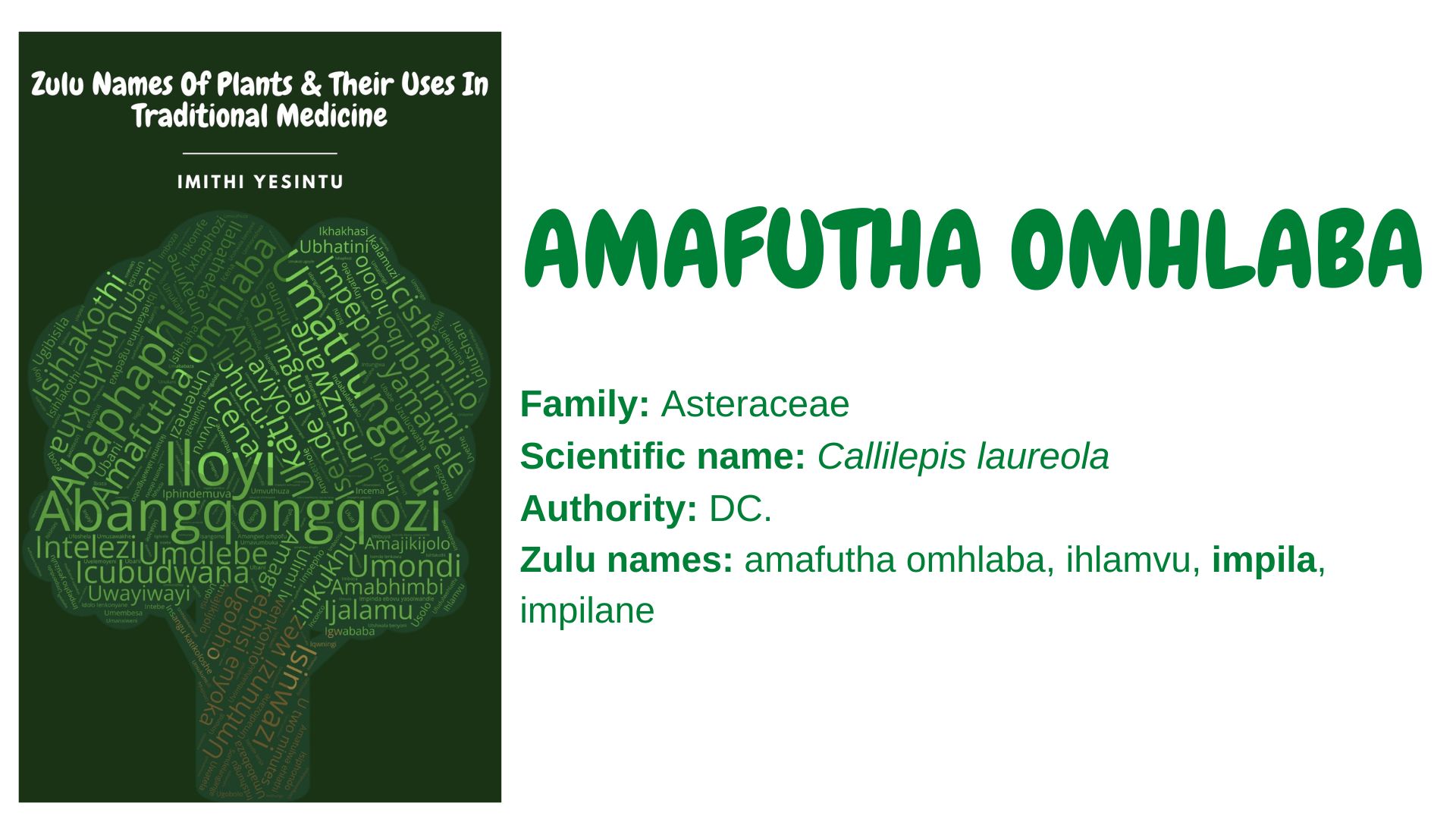Family: Asteraceae
Scientific name: Callilepis laureola
Authority: DC.
Synonyms: Callilepis glabra DC., Callilepis hispida DC.
Zulu names: amafutha omhlaba, ihlamvu, impila, impilane
Other names: oxe-eye daisy (English), wile margriet (Afrikaans)
Plant description: C. laureola is a herbaceous perennial plant that commonly grows in grassland habitat. It has bright green leaves that are variable in shape and size, solitary creamy white flowers with a dark disc, and tuberous roots similar to a potato with a pungent odour and bulbous shape. The plant (root) is highly poisonous and can be fatal when overdosed (misused or abused), some symptoms include confusion and convulsions.
Uses:
- The roots are dried and ground to fine powder and added to water when bathing to treat body sores.
- Bathing with the roots is also used as a protective charm to protect the children of parents who have already lost many children.
- The root is used to expel inyoni, a nervous disorder in children.
- The roots are used as a protective charm that is placed under a pillow to prevent bad dreams in adults.
- The roots are used to make a decoction that is taken as an emetic and enema, to treat food poisoning.
- The roots are used to make an infusion that is taken as enema. The enema is typically used on children that are always startled out of sleep.
- The roots are used to make an infusion that is taken as a purgative.
- The roots are used to make a decoction that is taken as a vermifuge, to get rid of intestinal parasitic worms.The roots are one of the ingredients used to make inembe, which is taken regularly by pregnant women to ensure an easy childbirth.
- The roots are one of the ingredients used to make isihlambezo, which is used to ensure the health of both mother and baby during pregnancy.
- The roots are used to make an infusion that is taken to treat infertility in women and impotence in men.
- The roots are used to make a tonic that is taken by young girls at the early stages of menstruation.
- The grounded roots are used to make a paste that is applied directly to open wounds and then covered with a bandage.
- The roots are used to treat ear problems.
- The roots are used to treat snake bites.
- The roots are used to make a cough mixture that is used to treat whooping cough.
- The roots are used to treat stomach problems, such as stomach cramps and indigestion.
- A piece of the root is used as ikhubalo, a protective charm. The root is hung on the neck of the child to prevent evil spirits from coming to them.
- A piece of the root is also carried to ward off evil or unclean spirits.
Safety precaution:
Using traditional medicine responsibly can enhance your overall health and well-being. Misuse and abuse can lead to complications. You can inquire about the correct use of traditional medicine from a knowledgeable herbalist and practitioner. You can also visit imithiyesintu.co.za or email: info@imithiyesintu.co.za to learn more about traditional medicine
References and further reading:
- Arnold, T.H., Prentice, C.A., Hawker, L.C., Snyman, E.E., Tomalin, M., Crouch, N.R., and Pottas-Bircher, C., 2002. Medicinal and magical plants of southern Africa: an annotated checklist. Strelitzia 13. National Botanical Institute, Pretoria.
- Anderson, P.E., Winke, K. and Ereapuaduoh, B.V., Phytochemical screening of solvent extracts from Callilepis laureola plant.
- Botha, J., Witkowski, E.T. and Shackleton, C.M., 2004. Market profiles and trade in medicinal plants in the Lowveld, South Africa. Environmental conservation, 31(1), pp.38-46.
- Bryant, A.T., 1966. Zulu medicine and medicine men. C. Struik, Cape Town (originally published in 1909 in the Annals of Natal Museum).
- Corrigan, B.M., Van Wyk, B.E., Geldenhuys, C.J., and Jardine, J.M., 2011. Ethnobotanical plant uses in the KwaNibela Peninsula, St Lucia, South Africa. South African Journal of Botany 77, pp. 346–359.
- Cunningham, A.B., 1988. An investigation of the herbal medicine trade in Natal/KwaZulu. Institute of Natural Resources Investigative Report Issue 29. Institute of Natural Resources, Pietermaritzburg.
- Doke, C.M., and Vilakazi, B.W., 1972. Zulu-English dictionary, second edition. Witwatersrand University Press, Johannesburg.
- Foden, W. and Potter, L. 2005. Callilepis laureola DC. National Assessment: Red List of South African Plants version 2020.1. Accessed on 2023/04/27
- Gerstner, J., 1941. A preliminary checklist Zulu names of plants with short notes. Bantu Studies.
- Gumede, M.V., 1990. Traditional healers. A medical doctor’s perspective. Skotaville Publishers, Braamfontein, South Africa.
- Hulme, M.M., 1954. Wild flowers of Natal. Shutter and Shooter, Pietermaritzburg.
- Hutchings, A., Scott, A.H., Lewis, G., and Cunningham, A., 1996. Zulu medicinal plants. Natal University Press, Pietermaritzburg
- Ngwenya, M.A., Koopman, A., and Williams, R., 2004. Zulu botanical knowledge – an introduction (Ulwazi lwamaZulu ngezimila: isingeniso). National Botanical Institute, Durban.
- Popat, A., Shear, N.H., Malkiewicz, I., Stewart, M.J., Steenkamp, V., Thomson, S. and Neuman, M.G., 2001. The toxicity of Callilepis laureola, a South African traditional herbal medicine. Clinical Biochemistry, 34(3), pp.229-236.
- Van Wyk, B.E., and Gericke, N., 2000. People’s plants. A guide to useful plants of southern Africa. Briza Publications, Pretoria.
- Wainwright, J., Schonland, M.M., and Candy, H., 1977. Toxicity of Callilepis laureola. South African Medical Journal, 52(8), pp.313-315.
- Watt, J.M., and Breyer-Brandwijk, M.G., 1962. Medicinal and poisonous plants of southern and eastern Africa, second edition. Livingstone, London.
You Can Order Your Copy Of The Book By Emailing: info@imithiyesintu.co.za
Feel Free To Add Other Uses Of This Plant In The Comment Section Below:

